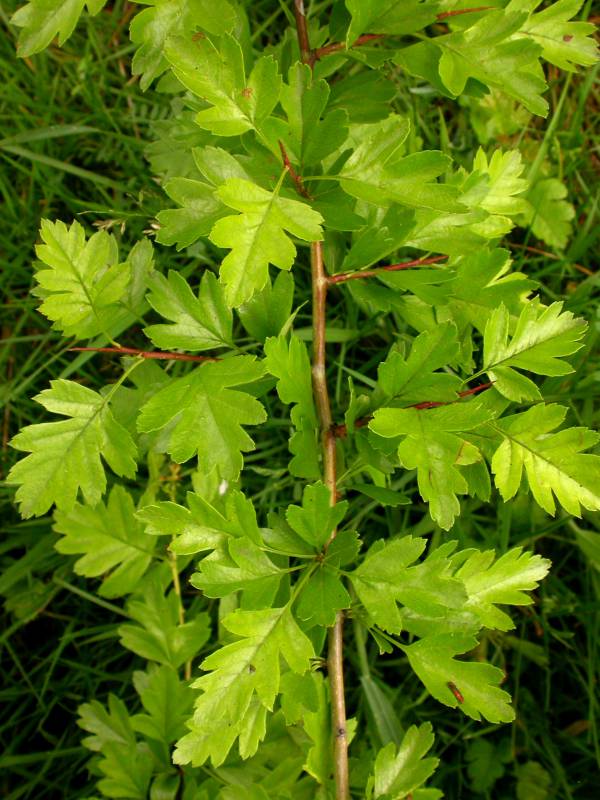Common hawthorn identification and control
Information about the noxious weed, common hawthorn. Common hawthorn is also known by its Latin name, Crataegus monogyna.
About this weed
Common hawthorn is a non-regulated Class C noxious weed. This means due to how widespread it is, property owners are not required to control this species on their property, though it is encouraged.
Common hawthorn is known as Crataegus monogyna and it is in the rose family. Other common names include English hawthorn and one-seed hawthorn.

Why it’s a problem
Common hawthorn is an introduced tree that has naturalized in the Pacific Northwest. This small tree rapidly spreads by seed into woodlands and open fields. It creates dense, thorny thickets that outcompete native species.
The thickets make it difficult for large animals to move around. Its red berries are attractive to birds and other animals, which help spread this tree far beyond where it is planted. Control is recommended in natural areas that are being restored to native vegetation, and in protected forest lands and wilderness areas.
Common hawthorn can be a nuisance species in pastures and wildlife grazing areas, so its removal from those areas is also recommended.
Plant description
Common hawthorn is a forest understory species in its native range, but in our area, it grows well in a wide range of habitats. This plant grows well in areas with moist soil. These habitats include areas near rivers and creeks, fields and pastures, shrub lands and grasslands, oak woodlands, and other forested habitats. This plant is native to Asia, Europe, and Northern Africa.
Common hawthorn is a thorny, deciduous (plant that loses its leaves annually) small tree or shrub, 6 to 30 feet tall. It looks like many other hawthorn species and often forms hybrids that have mixed characteristics.
The leaves are 3 to 7 lobed, 1 to 2 inches long as broad, and resemble mittens or paws.
The flowers are grouped in broad, dense, flat-topped clusters that look like cherry or apple blossoms. Petals are usually white, sometimes pink.
The fruit is a round, crimson berry that often stays into late winter.
Common hawthorn berries are spread by birds and other animals. A single tree can make over 2,000 berries. It flowers in spring and develops fruit in the fall. The berries often stay on the plant into the winter. When seeds pass through an animal, it aids germination but isn't necessary. Germination occurs mainly in the spring. Most vegetative growth occurs in spring and early summer. The normal growth rate is 1 to 2 feet a year.




Be aware of look-alike plants
Common hawthorn looks like many native and other non-native hawthorns. The most often found look-alike is the native black hawthorn (Crataegus douglasii). You can tell the difference between the two species by a few features. Black hawthorn has barely lobed leaves, and blackish fruits. While common hawthorn has deeply lobed leaves and bright red fruits. Hybrids frequently form and have mixed features of the parent plants.
When in doubt, take photos and report them on iNaturalist.
What to do if you find it
Because common hawthorn is so widespread, property owners in King County are not required to control it. King County is not generally tracking infestations. We can provide advice on how to control common hawthorn, but there is generally no legal requirement to do so.
The King County Noxious Weed Control Board encourages property owners to remove common hawthorn where possible, and to avoid introducing it to new landscapes.
Control methods
We recommend using a combination of methods to control weeds. In areas with few weeds, it is important to act quickly before they become harder to control. Make a long-term plan as it often takes several years to get rid of most weeds. Start in the least infested areas first and then move into more heavily infested areas.
Manual control
Seedlings and young saplings can be pulled or dug up when soil is moist. The roots quickly become deep and stout, and sharp thorns are present even on young seedlings. Mature trees have deep and extensive roots. Digging is labor-intensive and results in major soil disturbance if all the roots are removed. It often stump-sprouts, so removal by cutting alone is not effective.
Mechanical control
Cutting or mowing alone is not effective. But this can prevent berries and the spread of more plants. The plant should not be allowed to go to flower, so a strict mowing schedule is required.
Chemical control
Stay safe when using herbicide:
- Always read the label before use.
- Wear a long-sleeved shirt, long pants, shoes, and eye protection.
- Follow state and local regulations.
For plants that cannot be dug out, herbicide application may be considered. The most effective approach is using the cut stump or frilling method. Another option is foliar herbicide treatment, but it may result in spray drift to desirable vegetation.
See the PNW Pest Management Handbook for the most up to date and specific method for chemical control of common hawthorn.
Disposal instructions
All plant parts except for berries may be composted or put in yard waste. Berries should go in the garbage to prevent the spread of more plants.
Noxious Weed Disposal - Washington State Noxious Weed Control Board

 Translate
Translate